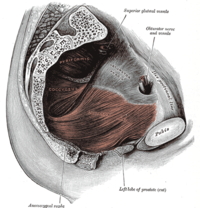
Photo from wikipedia
available at http://www.ncbi.nlm.nih.gov/pubmed/29170077 Editorial Comment: This team compared the readiness for transfer to an adult facility at their institution of 124 patients born between 1980 and 2003 with chronic bladder… Click to show full abstract
available at http://www.ncbi.nlm.nih.gov/pubmed/29170077 Editorial Comment: This team compared the readiness for transfer to an adult facility at their institution of 124 patients born between 1980 and 2003 with chronic bladder problems. The team instituted an adolescent transfer protocol in 2011. The authors divided the study population into a pretransfer protocol group (97 patients) and a posttransfer protocol group (27). A total of 61 patients from the pretransfer and 15 from the posttransfer group responded. The 2 main themes that emerged were 1) relationships, sexuality and fertility were discussed in only about 20% of patients before and after transfer, and 2) although discussions began in most instances at age 12 years, many patients were not ready to transfer to the adult care unit until after age 20 years. This was largely due to a personal bond with the pediatric urologist. Douglas A. Canning, MD Re: Evidence-Based Treatment of Multicystic Dysplastic Kidney: A Systematic Review A. Chang, D. Sivananthan, R. M. Nataraja, L. Johnstone, N. Webb and P. J. Lopez Departments of Paediatric Urology and Paediatric Nephrology, Monash Children’s Hospital and Department of Paediatrics, School of Clinical Sciences, Faculty of Medicine, Nursing and Health Sciences, Monash University, Melbourne, Victoria, Australia, and Department of Urology, Hospital Exequiel Gonzalez Cortes and Clinica Alemana, Santiago, Chile J Pediatr Urol 2018; 14: 510e519. doi: 10.1016/j.jpurol.2018.09.018 Abstract available at http://www.ncbi.nlm.nih.gov/pubmed/30396841 Editorial Comment: The authors performed a systematic review of all relevant studies published between 1968 and April 2017. There was a 3.2% risk (27 of 838 cases) of hypertension associated with multicystic dysplastic kidney (MCDK). Malignancy occurred in only 0.07% of patients (2 of 2,820). Of the patients 1,502 (53%) had total or partial involution of the dysplastic kidney. Given the low risk of hypertension and malignancy, the authors recommend a postnatal ultrasound at age 3 months, followed by a second ultrasound at age 12 to 24 months to confirm growth of the contralateral kidney and to identify involution of the MCDK. If the contralateral kidney is growing and has no other abnormalities, the authors recommend only annual blood pressure checks and urinalyses for protein, and 1 renal-bladder ultrasound after puberty. They recommend nephrectomy only in cases of uncontrolled persistent hypertension despite medical management, or an enlarging renal mass or ultrasound findings suggestive of progressive enlargement. Perhaps it is time to ease off our followup of infants with MCDK. I think this approach makes sense. Douglas A. Canning, MD 240 PEDIATRIC UROLOGY Copyright © 20 American Urological Association Education and Research Inc Unauthorized reproduction of this article is prohibite 20
Journal Title: Journal of Urology
Year Published: 2019
Link to full text (if available)
Share on Social Media: Sign Up to like & get
recommendations!